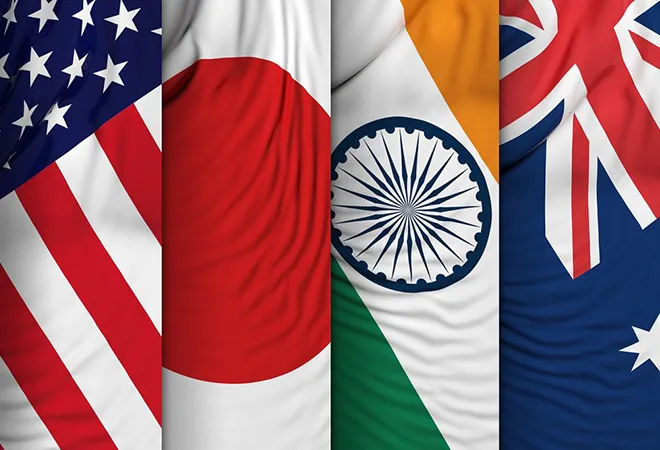 This article is part of the series—Raisina Edit 2021
This article is part of the series—Raisina Edit 2021
The new geography of the Indo-Pacific and the emerging Quad coalition—comprising of Australia, India, Japan and the United States—are widely seen as a profound discontinuity in the evolution of India’s international relations. Critics as well as supporters of the Indo-Pacific and the Quad agree on this proposition. The former oppose while the latter welcome Delhi’s apparent unmooring from the concepts of non-alignment and strategic autonomy that have defined independent India’s foreign policy for so long.
Even as India reframes its foreign policy away from the traditional framework of non-alignment, it has a big task in persuading Asian nations on the merits of the Indo-Pacific and the Quad. For there are deep anxieties across Asia about the potential for confrontation between the Quad and China. Many in the region have embraced the language of non-alignment in coping with the new geopolitical divide in Asia. Their concerns are similar to those that Delhi had invented and popularised in the years after the Second World War.
The key to the Indian efforts to win over the region to its point of view lies in the effective mobilisation of Asian nationalism. A close look at the evolution of India’s own non-alignment, which morphed into strategic autonomy after the Cold War, underlines the centrality of nationalism in navigating the shifting currents of great power relations.
When India adopted the path of non-alignment at the dawn of its independence, Delhi was reacting to the emergence of Cold War blocs and the attendant great logic—“with me or against me”. Having just won its independence after nearly two centuries of colonial rule, the Indian nationalists were loath to cede their freedom for manoeuvre on the global stage.
If India successfully demonstrated the possibilities for engaging both the East and the West for national benefit, Delhi did not hesitate to lean on one side when the conditions demanded for such alignments. Threatened by the Sino-US rapprochement, India turned to the Soviet Union in the 1970s to restore a balance to its regional security environment. But in the 1980s, Prime Ministers Indira Gandhi and Rajiv Gandhi recognised that India might have moved too far towards Moscow and sought to recalibrate its orientation by reaching out to the US.
After the Soviet Union collapsed, India naturally stepped up its engagement with the United States including in the arena of military cooperation. Yet, the fear of the unipolar moment saw India hedge against the potential threats from the US actions. Delhi chose to join the Russian initiative for the so-called ‘strategic triangle’ with China that eventually became the BRICS forum along with Brazil and South Africa.
As its security situation began to worsen amidst the rise of China and its assertiveness around India’s land and maritime frontiers in the 2000s, Delhi began to intensify its defence and security cooperation with the United States. If the case for strategic autonomy from the US saw India tilt towards Russia and China after the 1990s, the deepening power imbalance with China and its consequences has nudged India closer to Washington.
The continuous calibration of India’s great power relations was not driven by abstract notions of non-alignment and strategic autonomy but on the assessment of concrete conditions confronting India. But the political and academic discourse on India’s foreign policy tended to present non-alignment as an unchanging ideological framework in an anti-Western political orientation.
The story is much the same in the rest of Asia—barring a handful of nations that formally aligned with the US—alls other sought to maximise their freedom of action. China learnt to lean on one side or the other—first with Moscow and then with Washington—depending on the circumstances. Many opted for non-alignment but for others, the difference between alignment and non-alignment was not so clear cut.
Pakistan, which signed onto US anti-Communist alliances in the 1950s, had no difficulty embracing Red China to balance India. The Philippines and Thailand, treaty allies of the US, now have strong ties with China. South Korea, which depends on US military for its security, carefully navigates the dynamic between Washington and Beijing. Many in Southeast Asia, despite their close ties with the West, affirm their opposition to a new Cold War and refuse to choose sides between China and the Quad.
That brings us to the far more complex dynamic that presents itself in Asia today. Although the metaphor of the Cold War is quite common, it is important to note the differences between the US-Soviet confrontation and the current Sino-US rivalry. For one, Asia was not the main theatre of the former. This time, Asia and its waters are the main sites for great power confrontation. The conditions that Asia confronts today could increasingly look like the situation in Central Europe that bore the brunt of the US-Soviet confrontation.
For another, China is at the heart of Asia unlike Russia which sat at the eastern periphery of Europe. Finally, Asia today is deeply tied to the Chinese economy in a manner that Europe was never connected to Russia. Even more important, deep economic interdependence between the US and China adds a more complex layer to the relations between Washington and Beijing.
Sitting in China’s front-yard, worried about the constancy of American commitment to Asia, and warned by the economic punishment that Beijing has mooted to Australia, much of Asia has little appetite to stand in opposition to Beijing. It is no surprise that these concerns are dressed up in the language of neutralism and non-alignment.
It will be a profound mistake, however, to believe that Asian nationalism has given way to an acceptance of Chinese expansionism. To be sure, economic interdependence, the imperatives of political geography, and Beijing’s successful elite capture in many societies have made it difficult for many in Asia to contest the unfolding Chinese dominance over the region.
But as India has demonstrated in the great Himalayas during 2020, its own nationalism offers a powerful anti-dote to Chinese nationalism. While conditions differ along the Chinese periphery, Asian nationalism remains a powerful force. For the internationalists in the US, nationalism anywhere is an anathema. But to succeed in Asia, US needs to stand by the nationalist forces that have a stake in defending their territorial integrity and strategic autonomy. The success of the Quad, then, depends on two important factors. One is to offer alternatives to the deepening regional economic reliance on China and the other is to buttress its formulations on the rules-based order with tangible political and security support to those nations that are at the receiving end of Chinese power.
(Prof C. Raja Mohan is Director, Institute of South Asian Studies, National University of Singapore and a former member of India’s National Security Advisory Board).
ENDS
The views expressed above belong to the author(s). ORF research and analyses now available on Telegram! Click here to access our curated content — blogs, longforms and interviews.



 This article is part of the series—
This article is part of the series— PREV
PREV


